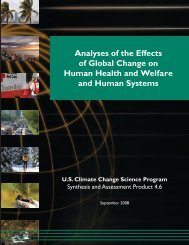Weather and Climate Extremes in a Changing Climate. Regions of ...
Weather and Climate Extremes in a Changing Climate. Regions of ...
Weather and Climate Extremes in a Changing Climate. Regions of ...
Create successful ePaper yourself
Turn your PDF publications into a flip-book with our unique Google optimized e-Paper software.
to the identification <strong>of</strong> change <strong>in</strong> a climate<br />
record that is statistically dist<strong>in</strong>guishable<br />
from the record’s previous characteristics. A<br />
typical example is the detection <strong>of</strong> a statistically<br />
significant trend <strong>in</strong> a temperature record. Here,<br />
detection <strong>and</strong> attribution <strong>in</strong>volves the assessment<br />
<strong>of</strong> observed changes <strong>in</strong> relation to those<br />
that are expected to have occurred <strong>in</strong> response<br />
to external forc<strong>in</strong>g. Detection <strong>of</strong> climatic<br />
changes <strong>in</strong> extremes <strong>in</strong>volves demonstrat<strong>in</strong>g<br />
statistically significant changes <strong>in</strong> properties<br />
<strong>of</strong> extremes over time. Attribution further<br />
l<strong>in</strong>ks those changes with variations <strong>in</strong> climate<br />
forc<strong>in</strong>gs, such as changes <strong>in</strong> greenhouse gases<br />
(GHGs), solar radiation, or volcanic eruptions.<br />
Attribution is a necessary step toward identify<strong>in</strong>g<br />
the physical causes <strong>of</strong> changes <strong>in</strong> extremes.<br />
Attribution <strong>of</strong>ten uses quantitative comparison<br />
between climate-model simulations <strong>and</strong> observations,<br />
compar<strong>in</strong>g expected changes due to<br />
physical underst<strong>and</strong><strong>in</strong>g <strong>in</strong>tegrated <strong>in</strong> the models<br />
with those that have been observed. By compar<strong>in</strong>g<br />
observed changes with those anticipated<br />
to result from external forc<strong>in</strong>g, detection <strong>and</strong><br />
attribution studies also provide an assessment <strong>of</strong><br />
the performance <strong>of</strong> climate models <strong>in</strong> simulat<strong>in</strong>g<br />
climate change. The relationships between<br />
observed <strong>and</strong> simulated climate change that<br />
are diagnosed <strong>in</strong> these studies also provide an<br />
important means <strong>of</strong> constra<strong>in</strong><strong>in</strong>g projections <strong>of</strong><br />
future change made with those models.<br />
A challenge arises <strong>in</strong> attribution studies if the<br />
available evidence l<strong>in</strong>k<strong>in</strong>g cause <strong>and</strong> effect <strong>in</strong><br />
the phenomenon <strong>of</strong> <strong>in</strong>terest is <strong>in</strong>direct. For example,<br />
global climate models are able to simulate<br />
the expected responses to anthropogenic<br />
<strong>and</strong> natural forc<strong>in</strong>g <strong>in</strong> sea surface temperature<br />
(SST) <strong>in</strong> tropical cyclone formation regions, <strong>and</strong><br />
thus these expected responses can be compared<br />
with observed SST changes to make an attribution<br />
assessment <strong>of</strong> the causes <strong>of</strong> the observed<br />
changes <strong>in</strong> SSTs. However, global climate<br />
models are not yet able to simulate tropical cyclone<br />
activity with reasonable fidelity, mak<strong>in</strong>g<br />
an “end-to-end” attribution <strong>of</strong> cause <strong>and</strong> effect<br />
(Allen, 2003) more difficult. In this case, our<br />
judgment <strong>of</strong> whether an external <strong>in</strong>fluence has<br />
affected tropical cyclone frequency or <strong>in</strong>tensity<br />
depends upon our underst<strong>and</strong><strong>in</strong>g <strong>of</strong> the l<strong>in</strong>ks<br />
between SST variability <strong>and</strong> tropical cyclone<br />
variability on the one h<strong>and</strong>, <strong>and</strong> upon the underst<strong>and</strong><strong>in</strong>g<br />
<strong>of</strong> how external <strong>in</strong>fluence has altered<br />
<strong>Weather</strong> <strong>and</strong> <strong>Climate</strong> <strong>Extremes</strong> <strong>in</strong> a Chang<strong>in</strong>g <strong>Climate</strong><br />
<strong>Regions</strong> <strong>of</strong> Focus: North America, Hawaii, Caribbean, <strong>and</strong> U.S. Pacific Isl<strong>and</strong>s<br />
SSTs on the other. In these cases, it is difficult<br />
to quantify the magnitude <strong>and</strong> significance<br />
<strong>of</strong> the effect <strong>of</strong> the external <strong>in</strong>fluences on the<br />
phenomenon <strong>of</strong> <strong>in</strong>terest. Therefore, attribution<br />
assessments become difficult, <strong>and</strong> estimates<br />
<strong>of</strong> the size <strong>of</strong> the anthropogenic contribution to<br />
an observed change cannot be readily derived.<br />
This problem <strong>of</strong>ten occurs <strong>in</strong> climate-change<br />
impacts studies <strong>and</strong> has sometimes been termed<br />
“jo<strong>in</strong>t attribution” (Rosenzweig et al., 2007).<br />
3.2.1.1 deteCtiOn <strong>and</strong> attributiOn:<br />
huMan-<strong>in</strong>duCed Changes <strong>in</strong><br />
average CliMate that affeCt<br />
CliMate extreMes<br />
This section discusses the present underst<strong>and</strong><strong>in</strong>g<br />
<strong>of</strong> the causes <strong>of</strong> large-scale changes <strong>in</strong> the<br />
climatic state over North America. Simple<br />
statistical reason<strong>in</strong>g <strong>in</strong>dicates that substantial<br />
changes <strong>in</strong> the frequency <strong>and</strong> <strong>in</strong>tensity <strong>of</strong><br />
extreme events can result from a relatively small<br />
shift <strong>in</strong> the average <strong>of</strong> a distribution <strong>of</strong> temperatures,<br />
precipitation, or other climate variables<br />
(Mearns et al., 1984; Katz <strong>and</strong> Brown, 1992).<br />
Expected changes <strong>in</strong> temperature extremes<br />
are largely, but not entirely, due to changes <strong>in</strong><br />
seasonal mean temperatures. Some differences<br />
between changes <strong>in</strong> means <strong>and</strong> extremes arise<br />
because moderate changes are expected <strong>in</strong> the<br />
shape <strong>of</strong> the temperature distribution affect<strong>in</strong>g<br />
climate extremes; for example, due to changes<br />
<strong>in</strong> snow cover, soil moisture, <strong>and</strong> cloud<strong>in</strong>ess<br />
(e.g., Hegerl et al., 2004; Khar<strong>in</strong> et al., 2007).<br />
In contrast, <strong>in</strong>creases <strong>in</strong> mean precipitation are<br />
expected to <strong>in</strong>crease the precipitation variance,<br />
thus <strong>in</strong>creas<strong>in</strong>g precipitation extremes, but decreases<br />
<strong>in</strong> mean precipitation do not necessarily<br />
Substantial changes<br />
<strong>in</strong> the frequency<br />
<strong>and</strong> <strong>in</strong>tensity <strong>of</strong><br />
extreme events<br />
can result from<br />
a relatively small<br />
shift <strong>in</strong> the average<br />
<strong>of</strong> a distribution<br />
<strong>of</strong> temperatures,<br />
precipitation, or<br />
other climate<br />
variables.<br />
83




